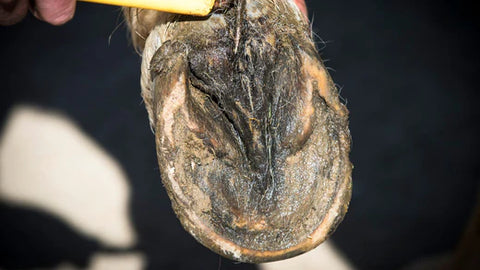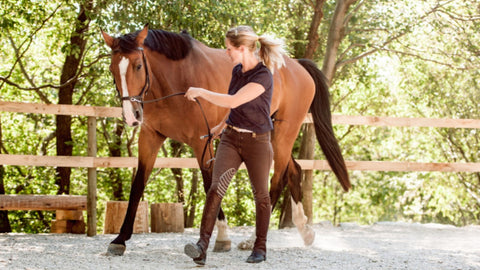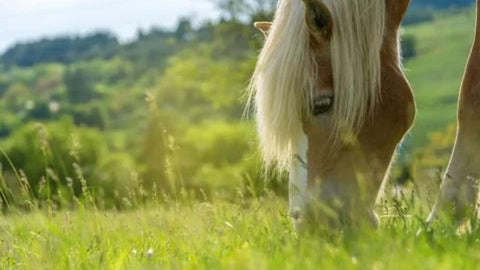
Florian ist aufgewachsen auf einem Bauernhof. Umgeben von Pferden, entdeckte er früh seine Faszination für diese majestätischen Tiere. Inspiriert von seiner reitbegeisterten Mutter, entwickelte er das Nahrungsergänzungmittel - Pferdegold. Seine tiefe Verbundenheit zur Natur und die leidenschaftliche Hingabe zu Pferden trieben ihn an, sein Unternehmen zu gründen.
Autumn brings not only colorful leaves and cooler temperatures, but also challenges for the health of horse hooves. Mud, wetness, and changing ground conditions can put a lot of strain on your horse's hooves.
Without hooves, nothing works, literally. That's why they should always be immaculately groomed—and healthy.
If they aren't, you risk thrush, cracked horn, laminitis, arthritis, back problems, tendon damage, and so on. Therefore, it's especially important to pay attention to your horse's hoof health in the fall.

Why is hoof care especially important in autumn?
Autumn is a critical time for your horse's hooves and the peak time for hoof problems. This is no surprise, given that horses often stand in mud for hours .
The horn softens , bacteria can penetrate and thrush can occur.
But even indoors, four-legged friends can ruin their hooves if the stable conditions are not ideal.
The grass in autumn also often contains more sugar , which can increase the risk of laminitis .
It is therefore especially important to practice consistent hoof care in the fall and to watch for signs of problems .

Perfect for your horse: Pferdegold® supplementary feed!
These specially developed supplements support your horse's diet and provide it with natural nutrients. Made in Germany, grain-free and drug-free, they come with a 30-day money-back guarantee.
Try it now!How do I care for the hooves in autumn?
Here are our five tips on how to keep your horse’s hooves healthy through the fall:
1. Please be sporty!
The most important thing of all: exercise . But this is often neglected in the fall – and this comes back to haunt us. Physical exercise is the key to healthy hooves. Exercise ensures good circulation and nourishment of the hooves.
Once the heart and blood circulation are properly stimulated, nutrients can be transported more effectively.
You can go one step further: It is best for the horse's hoof to become acquainted with different types of soil, as this stimulates growth.
2. Good stable hygiene
A thorough mucking out once a day is a must! If you neglect this and the bedding remains in the box for too long, it becomes a breeding ground for bacteria and putrefactive organisms.
The boxes must be cleaned daily. The feces-urine mixture is highly aggressive , decomposing even the best horn.
Therefore: Cheers to cleanliness! Regular and thorough cleaning of the stable is essential to ensure the health of your horse's hooves.

3. Fat and oil: good or bad?
Opinions differ here. Most experts agree: bad. Because the fat or oil completely seals the hoof . Then it can no longer absorb moisture .
This effect is known from silicone shampoos . Silicone is a plastic that forms a layer around the hair.
Initially, the hair feels sealed and beautifully soft and shiny , but over time it becomes dry and brittle . This is because the seal prevents any conditioning ingredients and moisture from penetrating the hair.
If the hooves are dry, you should not simply apply the full amount of hoof oil.
This does not help at all and in the worst case scenario makes the hooves even drier and brittle in the long run.
It's better to soak the hooves for 15 minutes beforehand and then apply the hoof oil . This way, the moisture stays in the hoof and doesn't evaporate as quickly.
4. The horse needs new horseshoes
Compared to humans, horses need new shoes frequently – on average every six to eight weeks .
If the horse has club feet or toes are too long, new hooves are often needed every two weeks . It goes without saying that the new "shoes" should fit perfectly.
Also important: Clean the horseshoes once a day . Don't be too rough , though, as this could damage the horn.
If your horse loses a horseshoe , please do not try to put it back on yourself!
Only a professional is allowed to do this . What can you do? Secure a diaper to the hoof with adhesive tape.
Bare-hoofed horses also need care. Their horn should be trimmed every four to twelve weeks. Of course, only by a professional.
5. Feed nutrients
Another cause of poor hooves can be nutrient deficiencies .
Many horses are deficient in certain nutrients, specifically zinc, manganese , and copper . For example, zinc. This trace element is important for hoof growth and supports the regeneration of hooves, feet, and skin.
So you buy a supplement. However, many supplements contain a veritable armada of industrial sugar , preservatives, flavorings, and sweeteners —all of which can ultimately harm the horse. That's a problem.

With the Pferdegold pellets your four-legged friend will get through the autumn well
Pferdegold® Hufe supports the regeneration of hooves, feet, and skin thanks to its high zinc content . Pferdegold Hufe was developed to combat nutritional deficiencies and promote hooves with targeted nutrient supply.

Pferdegold® supplementary feed!
Pferdegold is a small family business from Bavaria with a big dream: to produce the best horse feed. We see ourselves as a family of equestrians who want to provide your horse with the ideal nutrition. 100% natural and perfectly tailored to your horse's needs.
Try it now!In addition to zinc, Pferdegold Hoofs also contain manganese and copper , as well as biotin . Biotin, also known as vitamin B7, is an important nutrient for horses. A study published in the Equine Veterinary Journal shows that biotin supplementation can contribute to significant improvements in hoof growth rate and hardness .
Biotin is found primarily in green fodder, the very food that's increasingly rare in the fall. Therefore, a deficiency—and thus poor hooves—is not uncommon.
Good to know: Biotin is not a solitary animal. According to a study by the Hannover Veterinary School mentioned in Cavallo , it should always be fed together with zinc – as with Pferdegold Hufe.
Conclusion
Autumn brings with it special challenges, but with a little attention and care these can be mastered.
Consistent hoof care, sufficient exercise and proper nutrition can prevent many problems before they even arise.
And don't forget that even the best products are only as good as the regular care you give your pet.
With the right strategies and products, like our Horse Gold Pellets , you can ensure you're doing the best you can to ensure your horse's hooves carry him safely through every season.
FAQ
Why is hoof care especially important in autumn?
Hoof care in the fall is crucial because the season of muddy and wet conditions, as well as changing ground conditions, can affect the health of a horse's hooves.
Wet soils can soften the hoof horn and allow bacteria to penetrate, which can lead to hoof problems such as thrush. Furthermore, autumn grass often contains more sugar, which increases the risk of laminitis. Therefore, it's important to pay attention to hoof health in the fall.
What measures should I take to care for my hoof in the fall?
In autumn there are some important measures for hoof care:
-
Exercise: Ensure your horse gets enough exercise to promote blood circulation and the supply of nutrients to the hooves.
-
Stable hygiene: Clean the box thoroughly every day, as neglected bedding can be a breeding ground for bacteria.
-
Hoof oil and grease: Use hoof oil after soaking the hooves to retain moisture, but avoid excessive use, which can dry out the hooves.
-
Horseshoes: Monitor the condition of the horseshoes and have them replaced on time to keep the hooves in good condition.
- Nutrients: Make sure your horse gets the right nutrients, especially zinc, manganese, copper, and biotin, to promote hoof growth and hardness.
Good to know
- The horn grows on average six to eight millimeters per month.
- How quickly hooves grow depends on the breed and age. Warmbloods, as well as young horses, experience faster growth.
- Hooves also hibernate: in the cold season they grow more slowly than in summer.
- However, Winterhorn is harder than Sommerhorn.
- Light-colored hooves grow faster than dark-colored ones. Mixed-colored hooves grow slowest.
- The horn of barefoot horses grows faster than that of shod horses.
- The hooves of horses that enjoy exercise grow faster.
- The quality of the horn depends on the breed.
Important:
Pferdegold is not a substitute for veterinary diagnosis or treatment. The information contained in this article is for general informational purposes only and is intended to help improve your horse's well-being.Pferdegold products do not treat or cure diseases , but rather support your horse in compensating for nutritional deficiencies through targeted nutrient intake .
However, they are not a substitute for professional advice from a veterinarian or specialist. If your horse has any health problems, we strongly recommend consulting a veterinarian. Pferdegold assumes no liability for decisions made based on the information provided here.

















